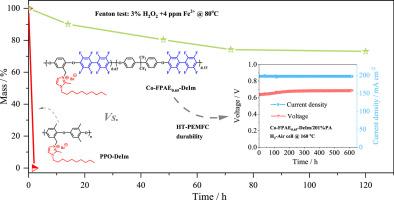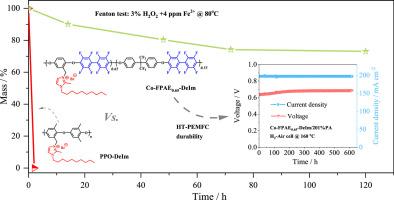氟化聚芳醚是一种具有优异化学稳定性的大体积咪唑功能化材料,可用于高温质子交换膜燃料电池
IF 5.6
3区 材料科学
Q1 ELECTROCHEMISTRY
引用次数: 0
摘要
开发具有优异化学稳定性的聚合物电解质膜是高温质子交换膜燃料电池(ht - pemfc)广泛应用和商业化的关键。本文报道了以4,4′-(六氟异丙基)二酚(6FDP)为共聚物,通过十氟联苯(DFBP)和甲基对苯二酚的亲核缩聚,合成了含氟聚芳基醚(FPAE)共聚物。为了提高磷酸(PA)的掺杂能力,同时控制尺寸膨胀,将大块的1-癸基-2-甲基咪唑(DeIm)基团接枝到聚合物主链上。所得的均聚物FPAE-DeIm膜表现出优异的氧化稳定性,在80 °C的Fenton试剂(3 wt% H2O2 + 4 ppm Fe2+)中,在120小时后保持其初始质量的68%,大大优于传统的deim接枝聚(2,6-二甲基-1,4-苯基氧化物),后者在2小时内降解。引入刚性和疏水性聚(DFBP-6FDP)单元进一步提高了化学耐久性和抑制体积膨胀。因此,Co-FPAE0.65-DeIm表现出最佳的性能平衡:芬顿测试后质量保持率为73%,在150 °C下85 wt% PA下体积膨胀率为55%,室温下抗拉强度为15.5 MPa, 180 °C时质子电导率为78.3 mS cm-1。值得注意的是,在160 °C的干燥氢气/空气中,在没有背压的情况下,在200 mA cm-2的恒流操作下,该膜在617小时的测试中没有出现降解迹象。在此期间,峰值功率密度从319增加到420 mW cm-2,电池电压从0.633 V提高到0.683 V。这些结果将Co-FPAEx-DeIm膜定位为高度耐用和高效的ht - pemfc,强调了在ht - pemfc中长期运行的潜力。本文章由计算机程序翻译,如有差异,请以英文原文为准。


Fluorinated poly(arylene ether)s functionalized by bulky imidazolium with excellent chemical stability for high-durability high temperature proton exchange membrane fuel cell applications
The development of polymer electrolyte membranes with superior chemical stability is critical for the widespread application and commercialization of high temperature proton exchange membrane fuel cells (HT-PEMFCs). Herein, we report the synthesis of fluorinated poly(aryl ether) (FPAE) copolymers via nucleophilic polycondensation of decafluorobiphenyl (DFBP) and methylhydroquinone, incorporating 4,4′-(hexafluoroisopropylidene)diphenol (6FDP) as a co-monomer. To enhance phosphoric acid (PA) doping capacity and simultaneously control dimensional swelling, bulky 1-decyl-2-methylimidazole (DeIm) groups are grafted onto the polymer backbone. The resulting homopolymer FPAE-DeIm membrane exhibits an excellent oxidative stability, retaining 68 % of their initial mass after 120 h in Fenton’s reagent (3 wt% H2O2 + 4 ppm Fe2+) at 80 °C, vastly outperforming conventional DeIm-grafted poly(2,6-dimethyl-1,4-phenylene oxide), which degrades within 2 h. The introduction of rigid and hydrophobic poly(DFBP-6FDP) units further enhances chemical durability and suppresses volume swelling. Consequently, Co-FPAE0.65-DeIm exhibits an optimal balance of properties: 73 % mass retention after Fenton test, a volume swelling of 55 % in 85 wt% PA at 150 °C, a tensile strength of 15.5 MPa at room temperature, and a proton conductivity of 78.3 mS cm-1 at 180 °C. Remarkably, under constant current operation (200 mA cm-2) at 160 °C in dry H2/air without backpressure, the membrane showed no signs of degradation over a 617-hour test. During this period, the peak power density increased from 319 to 420 mW cm-2, while the cell voltage improved from 0.633 V to 0.683 V. These results position Co-FPAEx-DeIm membranes as highly durable and efficient HT-PEMs, underscoring the potential for long-term operation in HT-PEMFCs.
求助全文
通过发布文献求助,成功后即可免费获取论文全文。
去求助
来源期刊

Electrochimica Acta
工程技术-电化学
CiteScore
11.30
自引率
6.10%
发文量
1634
审稿时长
41 days
期刊介绍:
Electrochimica Acta is an international journal. It is intended for the publication of both original work and reviews in the field of electrochemistry. Electrochemistry should be interpreted to mean any of the research fields covered by the Divisions of the International Society of Electrochemistry listed below, as well as emerging scientific domains covered by ISE New Topics Committee.
 求助内容:
求助内容: 应助结果提醒方式:
应助结果提醒方式:


